Raboyseyee and Ladies,
The Unnamed Zookeeper: What’s In a Name?
Welcome to the Hebrew month of Cheshvan. Or, is it Mar-Cheshvan? Well, that depends on whom one consults for the correct answer. It so happens that this past Shabbat, the heylige Ois was leading the davening, which included Rosh Chodesh Bentching (the blessing recited in advance of the upcoming Hebrew month). The month blessed is Mar-Cheshvan -either a one-word or two-word name. And so taka, I pronounced the month as I led the congregation.
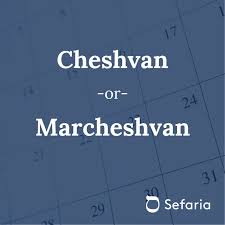
So far so good until Mincha at 1:30 PM, when at another shul, two gentlemen -let’s call them Sam Shore and Zach Cohen summoned me over to ask about the correct name of the month. Is it Cheshvan, and that would make sense because every Hebrew calendar the Ois has seen and consulted over the years – be they from Apple Bank, Chabad, Chai Lifeline, Lakewood, all shuls, and many others- spell the month that way? Or, are all the calendars, school projects, and sukkah decorations wrong, and the correct name is Mar-Cheshvan? If it’s Cheshvan as do the calendars indicate, why did I, and the rest of the world bless Mar-Cheshvan?
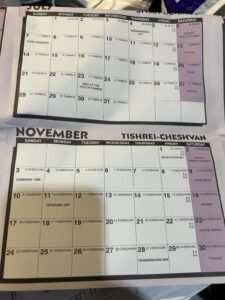
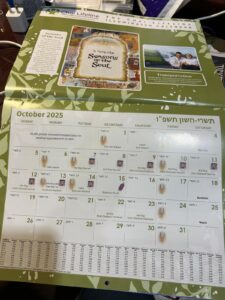
If it is colloquially called Mar-Cheshvan, is it because the word ‘Mar’ was added to mean ‘bitter,’ suggesting that the upcoming month may feel bitter compared to the preceding month(s)? Or, is the month really called Mar-Cheshvan because that is its name as the Ois called it out in shul? And if it is called Mar-Cheshvan, why? What does the word Mar mean when it precedes Cheshvan? Why did calendars -mamish all of them- drop the Mar from the Cheshvan?
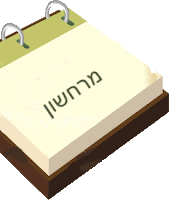
This question, and others, were on my mind as Sam and Zach both told me that my understanding of the name Marcheshvan was incorrect. But was I? The discussion was timely because I was grada thinking about what to cover this week -besides Noiach’s nakedness which we have discussed several times in the past 15 years (this being the Ois’s 16th time around the parsha). I had thought to zero in on an unsung, unnamed but important person in the parsha, but after being told I was wrong about the month’s name, I decided to cover both since both topics are related to a name. We will circle back to the Cheshvan controversy but let’s begin here.
Let’s talk about Mrs. Noiach — or more accurately, the nameless Mrs. Noiach, because when the Heylige Toirah lists the passengers of the Tayvo (Ark), it’s very thorough: Noiach, his sons, the wives of his sons… and then there’s her. Not a name, not a footnote, just “your wife.” The nameless Mrs. Noiach has no direct dialogue. She appears only four times, always as “ishtoy” — his wife (Bereishis 6:18, 7:7, 7:13, 8:16). But she’s clearly there for the entire story:
- She enters the Ark with Noiach and the sons’ wives.
- She survives the Mabul (flood).
- She leaves the Ark and helps rebuild humanity (Bereishis 8:16).

That’s the entire biblical coverage of her, and yet, without her, the entire project sinks before it even floats. She’s the first woman to survive a global flood, feed lions, manage a household of eight humans and an entire zoo. She’s probably the first ever multitasker and yet completely anonymous. It’s taka emes that she’s referred to directly by the RBSO several times and is included -always- in any direct orders given by the RBSO to Noiach, ober (but or however) she remains nameless.

Let’s look at the pisukim innaveynig:
Bereishis 6:18: וְאַתָּה, תָבֹא אֶל-הַתֵּבָה, אַתָּה וּבָנֶיךָ וְאִשְׁתָּךְ, וּבְנֵי בָנֶיךָ, עִמָּךָ; לְמִשְׁמַר אֶת-הַדָּבָר הַזֶּה.
“But with thee will I establish my covenant; and thou shalt come into the ark, thou, and thy sons, and thy wife, and the sons’ wives with thee, to keep them alive with thee.”
Bereishis 7:7: וַיֵּבֹא נֹחַ, וּבָנָיו, וְאִשְׁתּוֹ, וּנְשֵׁי בָנָיו, אִתּוֹ אֶל-הַתֵּבָה, מִפְּנֵי הַמָּיִם.
“And Noah went in, and his sons, and his wife, and the sons’ wives with him, into the ark; because of the waters of the flood.”
Bereishis 7:13: בַּחֹדֶשׁ הָשְׁמִינִי, בְּשִׁבְעָה עָשָׂר יוֹם לַחֹדֶשׁ, בַּיּוֹם הַזֶּה נִכְנַסוּ נֹחַ וּשְׁלשָׁת בָּנָיו, וְאִשְׁתּוֹ, וּנְשֵׁי בָנָיו, אִתּוֹ, אֶל-הַתֵּבָה;
“In the six hundredth year of Noah’s life, in the second month, on the seventeenth day of the month, on this day Noah went in, and his sons, and his wife, and the sons’ wives with him, into the ark.”
The bottom line: Nowhere in the heylige Toirah does the RBSO speak directly to Mrs. Noiach. She is always referenced indirectly as “your wife” (אִשְׁתָּךְ), “the wife of Noiach” — included in instructions to Noiach. And guess what? As you all know, she’s not the first female Toirah personality to go nameless. Just last week we mentioned that Kayin and Hevel were, according to some- born with twin sisters. In fact, in one medrish, Hevel was a triplet having been born with two twin sisters, and this may have sparked Kayin’s jealous rage; you know the rest. Ober did the Toirah mention sisters being born? Not? Were they ever named? Not! Ober, let us not feel too badly for them; they did -after all- get to spend some time in Gan Eden; that’s a greater achievement than most.
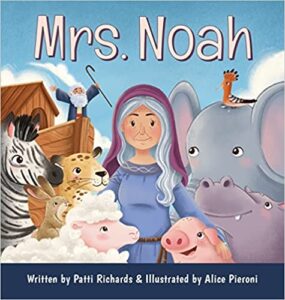
And by now raboyseyee, you know the drill: What to do when the heylige Toirah doesn’t mention Mrs. Noiach by name? A name is made up. Lacunas always invite midrashic imagination and moral lessons. And, let us not feel too badly for Mrs. Noiach because our sages (Chazal) also felt this was unfair. How could she go down in history nameless? Shoin, license was given -or taken- by various exegetes and medroshim who decided -many many years later- to name her based on attributes they felt she may have possessed. Why not? At times, we taka name babies hoping for them to have certain attributes; in the case of the medrish and with clear hindsight as to her role and achievements, deciding on a name was a layup. Who was going to prove otherwise? So, the rabbis gave her a name, in fact, different rabbis gave her different names -depending on which medrish one consults.
Says the Midrash Rabbah 23:3 that her name was Na’mah who was the daughter of Lemach and the sister of Tubal-Kayin. As an aside if you go back one parsha to the chamishi (5th) aliya, you will find a Rashi which tells us that Lemach had two wives. Why two? Says Rashi that one was for having children and the other was his sex toy. Ok, Rashi doesn’t say exactly that but does say that one was fornication purposes only. Think the Ois is making this up? Check it out, I dare you! And the Ois’s take on this? Anyone with two wives where one is stam azoy a sex toy, is not a Lemach; he’s Melech, a king! In any event, Rashi in our parsha tells us this about Na’amah, (נַעֲמָה), let us read the quote:
“וְאִשְׁתּוֹ נַעֲמָה – זוֹ נַעֲמָה בַּת לוֹמֶךְ, שֶׁנֶּאֱמַר ‘וַאֲחוֹת תּוּבַל קַיִן נַעֲמָה.’” She was called Na’amah “because her deeds were pleasant (ne’imim).” Nice.

Targum Yoinoson suggests her name was Emzara, “mother of the living,” or, “mother of the generations” — emphasizing her role as foundress of post-flood humanity. And taka, after the mabul, she was the mother of all living. Who was alive? Her family. And Pirkei d’Rebbi Eliezer prefers Tzila, the “shadow,” symbolizing protection and modesty and emphasizing her protective, behind-the-scenes role.
Each name highlights a different virtue: kindness, life-giving power, stealthy heroism. Apparently, Mrs. Noiach – be she Na’amah, Emzara, or Tzila was like a Heylige Toirah Swiss Army knife — all-purpose, indispensable, and yet invisible to the untrained eye. Were any of names chosen by our medroshim her real name? Ver veyst? A birth certificate is hard to track down.
Now, Mrs. Whomever is hardly alone to go nameless in Heylige Toirah. Let’s shout out Loit’s wife? She was nameless — until she became a pillar of salt. Of course, we all remember Mrs. Potiphar -the seductress who yelled rape when Yoisef would not respond to her advances, was also nameless despite nearly toppling the future redeemer of the Jewish people. And while we are unmasking the unnamed, let’s also shout out Bas- Paroy (Pharoh’s daughter) who was introduced to us only as Bas Paroy. She was never named in the Toirah, though Chazal (and later sources) give her a name — in fact, two or three possible names. Wait, we’re not done yet. Interestingly, when the unnamed are finally named in the medrish, they hardly all agree to the name. There are others to include the maid of the Shunammite woman? Also nameless — even as she plays a crucial role in a miracle.
And the lesson of all this? Mrs. Noiach is in good company and not that unique. Several significant women in Tanach went nameless. It epes appears like the Heylige Toirah has a subtle lesson: sometimes the women who move the story forward don’t need a name to leave a mark. They are the ultimate anonymous. Heroism, it seems, isn’t always about recognition. For some reason, the RBSO decided she wasn’t name-worthy and shoin. The bottom line is azoy: Unnamed Mrs. Noiach is part of a pattern: Often, the women who play critical narrative or moral roles but are secondary to the story’s “male hero” remain unnamed. Azoy geyt iz (that’s how it goes).
That said, let’s imagine a day in the life of Mrs. Noiach on the Tayvo. Feeding lions, tigers, and bears. Herding elephants into stalls with no “Animal Planet” instructions. Calming the children when the flood waters rise. Likely inventing organizational systems, nap schedules, and emergency evacuation plans for the giraffes. And the waste?! Oh my! All this without a name or a byline. The good news: Chazal hint at her tremendous fortitude and if anyone earned a spot in the hall of unsung heroes, it’s her. And taka says the Ramban that the Heylige Toirah emphasizes Noiach’s righteousness and obedience, but the Tayvo itself was a household project, a team effort. Mrs. Noiach embodies quiet diligence and faithfulness: her work is essential, but her reward is hidden. Another bottom line: Sometimes greatness doesn’t need a public announcement; sometimes it is measured in lives saved, not in stories told.
Ober, do the variety of names -at least three- assigned to her posthumously, tell us something deeper about Mrs. Noiach? Those who speak at a sheva brochis this week where the kallah’s name matches up to one of Mrs. Noiach’s midrashic names are in heaven. Need an example of kindness? Call her Na’amah. Protective mother? Tzila. Life-giver and spiritual backbone? Emzara. The Heylige Toirah allows us to find a heroine who fits a lesson, a moment, this week’s column — and that is her enduring power. And this raboyseyee and ladies is the beauty of the heylige Gemora and medrish; any teaching moment, story, or quote needed, can be found. The bottom line: The rabbis of the medrish didn’t have to agree on her identity; they were inventing her persona to make sense of the story. Gishmak!
So, as we read about Noiach and his adventures this year, let’s raise a glass to the first unsung heroine of Jewish history. Shkoiach for assisting your husband, whom the RBSO called upon to build the Ark and save his family. She didn’t get a name in the Heylige Toirah, but she deserves a column, a medrish, a dedication from the heylige Ois, and maybe even a statue floating above the Hudson. So happens that several statues have disappeared in the past few years because they were politically divisive; who’s going to object to a Mrs. Noiach statue or memorial? Let’s honor Mrs. Noiach: the quiet backbone of the survival of humanity, the original multitasker, and the most patient woman in history.
And while it took centuries and the medrish for Mrs. Noiach to get a name – several in fact as mentioned- the month of Cheshvan does have a name from day one. Maybe two! Shoin, let’s get back to the month of Cheshvan, which is marked yesterday and today. If months had feelings, Mar-Cheshvan would be in therapy. Ershtens (firstly), it knows not its own name; what taka is the proper name of the month? And it gets zero attention. There is mamish nothing happening in Cheshvan! The heylige month of Tishrei got all the attention—Rosh Hashono, Yom Kippur, Sukkis, Shmini Atzeres. Or, shofar, fasting, sukkah, simcha, food festivals, and lots of family sleeping and eating over, the whole production. Kislev has Chanukah parties, gifts, and oil that never runs out. Even poor Teves has a fast day! But Mar-Cheshvan? Bubkes. Not a single Yom Tov, minhag, unless one counts the weekly kiddish club festivities. Gornisht! We did though come close. Our sages tell us that King Shlomo finished building the Beis HaMikdash in this very month, but the dedication got pushed off till Tishrei. Since then, Cheshvan’s been the guy who built the stage and wasn’t invited to the concert. Ober, what is its real name? Let us begin with its Babylonian roots. Says the heylige Gemora (Megillah 11a), azoy:
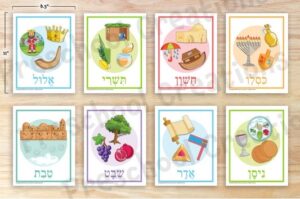
“שמות החדשים עלו עמהם מבבל” — The names of the months came up with them from Babylonia. Which means what? Pshat is azoy: Before the Babylonian exile, the Heylige Toirah’s months were simply numbered — “חודש הראשון”, “השביעי”, etc. meaning month one, two, three, etc. Only later did the names Nisan, Tammuz, and Mar-Cheshvan enter Jewish usage. Who made them up? Scholars (see Jastrow and others) note that Mar-Cheshvan comes from the Akkadian “Waraḥ-shamnu,” literally “eighth month.” “Waraḥ” = month + “Shamnu” = eight. Over time, Waraḥ-shamnu → Mar-Cheshvan. The “m” sound of “shamnu” slid into “Mar” — a linguistic hangover from Babylon! The bottom line: As it turns out, even our calendars have Babylonian DNA. The names stuck like cholent on a pot and on our waistlines.
That’s nice, but how did the word Mar get separated? Seemingly, once the Yiddin forgot the Akkadian meaning, Mar got reinterpreted in Hebrew: Mar = Bitter (מר). Says the medrish Yalkut Shimoni (Melachim I, Remez 184), azoy: A month without Yomim Tovim = a bitter month! Unlike every other month, Cheshvan has zero festivals. As mentioned, Cheshvan lost out to Tishrei for the rededication of the temple. That’s the bad news, ober (but) the Ois does not disappoint and closes with some good news: Says the medrish so gishmak, azoy: אמר הקב״ה: אני עתיד להחזיר לו
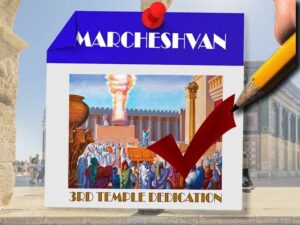
The RBSO promised to “repay” Cheshvan; the Third Beis HaMikdash will be dedicated in Cheshvan. So its bitterness will one day turn to sweetness. The bottom line: Poor Mar-Cheshvan stood by quietly while Tishrei hogged all the big holidays and got promised a make-up party at the end of days. Cute but let’s try this pshat on for size:
Mar also translates to a drop (of water). It does? So says the heylige Novee: Yeshayahu 40:15 — “הן גוים כמר מדלי” — “The nations are like a drop (mar) from a bucket.” Based on this pshat, many commentaries (see R’ Yaakov Emden, Siddur Beis Yaakov) say Mar-Cheshvan celebrates the start of the rainy season — the “raindrop month.” We begin saying Mashiv haruach u’morid hagashem in Tishrei, but the actual rains begin now — in Mar-Cheshvan. And if that’s pshat, efsher can kler that Mar-Cheshvan isn’t bitter at all — it’s the month of blessed marim, raindrops! Call it the Wettest Month of the Year — spiritually speaking.”
Wait, not done yet because another medrish (Pirkei d’Rebbi Eliezer, ch. 23) says that when Noiach left the Ark, it was in Mar-Cheshvan — and he offered korbanos then. And if all that’s true -and why shouldn’t it be- in some sense, Cheshvan was the month of renewal after destruction. What does that mean for us, you and me? If Noiach could start fresh in Mar-Cheshvan, so can we — even if our Yom Kippur resolutions already drowned. Oy vey!
And we finally -this time for real- close with this. Given all these wonderful medroshim about Mar-Cheshvan, why did we keep “Mar” in the Chodesh announcement this past shabbis? It’s seemingly azoy: The siddur and bentching Rosh Chodesh announcements retain the full, ancient Babylonian name — Mar-Cheshvan. Ober, the calendars dropped the “Mar” for simplicity. And the emes is that Cheshvan isn’t bitter—it’s Mar-Cheshvan. That mysterious “Mar” isn’t a typo; it’s the last remnant of a Babylonian word that meant “the eighth month.” Somewhere between Bovel and Boro Park, the “Mar” got adopted, reinterpreted, and dressed up with various exegesis. When our ancestors schlepped back from Bovel, they brought the name along with their new accents and, probably, a few idolatrous neighbors. Shoin! Somewhere along the way, “Waraḥ-shamnu” became “Mar-Cheshvan,” and then just “Cheshvan.” The “Mar” got separated, like a confused guest who wasn’t sure which table he belonged at, and rabbis through the ages rushed in to give it meaning: Mar — bitter, because it has no Yomim Tovim; Mar — raindrop, because it’s when the heavens finally open. Either way, Mar-Cheshvan’s got depth — it’s the only month with no party now, but it’s slated to host the grandest one ever when the Third Beis HaMikdash finally opens for business. That’s it, no other reason. Liturgy kept it, the printers dropped it. Ober, which is the correct form? Says Rav Yaakov Emden (Siddur, Beis Yaakov, Hilchos Rosh Chodesh) that Mar-Cheshvan is the more authentic form. The next time you hear the chazan announce Rosh Chodesh Mar-Cheshvan in shul, he will be channeling a 2,500-year-old Babylonian tradition. The Bnei Yissaschar (Ma’amarei Chodesh Mar-Cheshvan) says that Mar-Cheshvan contains hidden holiness precisely because it has no revealed Yom Tovim. Its sanctity is concealed, waiting to be revealed when Mashiach comes. Hence, “Mar” — bitter now, but sweet then. The final bottom line is this: “Mar-Cheshvan teaches that holiness doesn’t always come wrapped in a three-day Yom Tov with kugel. Sometimes, the quiet months carry the deepest blessings.”
As to Sam and Zach….what they suggested was taka the real origin of the name, but what they did not take into account were the various medroshim about the name and name change, including one that the Ois suggested.
A gitten Shabbis-
The Heylige Oisvorfer Ruv
Yitz Grossman
